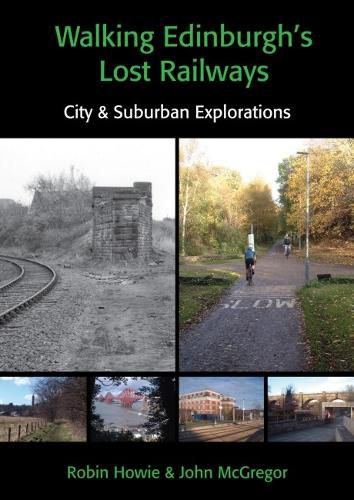Readings Newsletter
Become a Readings Member to make your shopping experience even easier.
Sign in or sign up for free!
You’re not far away from qualifying for FREE standard shipping within Australia
You’ve qualified for FREE standard shipping within Australia
The cart is loading…






Within the City of Edinburgh, there are many miles of "dismantled railway" that have been transformed into smooth, gently-graded, tarmac routes, ideal for pedestrians of all ages (especially young families), for cyclists and for joggers. The railway engineers, who balanced excavation and infill, have left a legacy of cuttings and embankments which are generally unobtrusive and often surprisingly tucked away from today's city life.
In 1981 Lothian Regional Council acquired various disused lines and other railway land, making possible the creation of cycleways-cum-footpaths. The programme began in 1983 and has flourished ever since. More might have been achieved had the line closures of the 1960s been accompanied by comprehensive plans for re-utilisation, which the mood of the times did not favour. There was instead piecemeal redevelopment for domestic housing, commerce and industry. Although a more enlightened policy subsequently prevailed, these results are not easily undone.
Nevertheless, the maze of track beds has very largely been preserved covering a total of some 40 miles - in part the product of inter-company rivalry and duplicated provision. Thirteen walks are described and, although each stands alone, tackling them in sequence opens windows on two centuries of urban expansion which has subsumed once-independent communities, all with their own histories.
The first walks described begin at Waverley Station in the city centre. Where track beds have been lost - especially through parts of old Leith - exploratory detours are detailed. The authors therefore advise that more time is allowed than the distances cited may suggest!
$9.00 standard shipping within Australia
FREE standard shipping within Australia for orders over $100.00
Express & International shipping calculated at checkout
Within the City of Edinburgh, there are many miles of "dismantled railway" that have been transformed into smooth, gently-graded, tarmac routes, ideal for pedestrians of all ages (especially young families), for cyclists and for joggers. The railway engineers, who balanced excavation and infill, have left a legacy of cuttings and embankments which are generally unobtrusive and often surprisingly tucked away from today's city life.
In 1981 Lothian Regional Council acquired various disused lines and other railway land, making possible the creation of cycleways-cum-footpaths. The programme began in 1983 and has flourished ever since. More might have been achieved had the line closures of the 1960s been accompanied by comprehensive plans for re-utilisation, which the mood of the times did not favour. There was instead piecemeal redevelopment for domestic housing, commerce and industry. Although a more enlightened policy subsequently prevailed, these results are not easily undone.
Nevertheless, the maze of track beds has very largely been preserved covering a total of some 40 miles - in part the product of inter-company rivalry and duplicated provision. Thirteen walks are described and, although each stands alone, tackling them in sequence opens windows on two centuries of urban expansion which has subsumed once-independent communities, all with their own histories.
The first walks described begin at Waverley Station in the city centre. Where track beds have been lost - especially through parts of old Leith - exploratory detours are detailed. The authors therefore advise that more time is allowed than the distances cited may suggest!